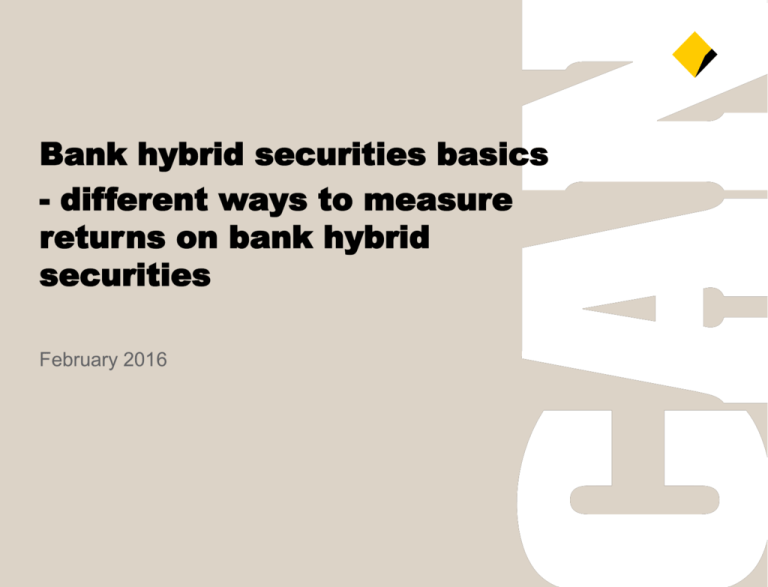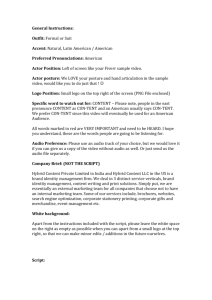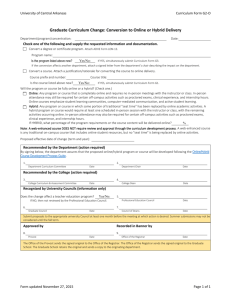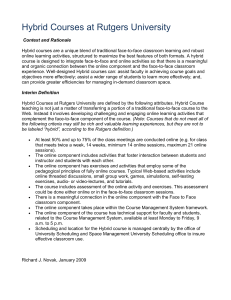Learn more
advertisement

Bank hybrid securities basics - different ways to measure returns on bank hybrid securities February 2016 Important information and disclaimer This presentation has been provided for educational purposes only, and is not, and does not constitute, financial product advice, an offer to sell or the solicitation, invitation or recommendation to purchase any securities and neither this presentation nor anything contained herein shall form the basis of any contract or commitment. The presentation has been prepared without taking into account your investment objectives, financial situation or particular needs (including financial and taxation issues). This presentation is not a replacement for professional advice, and you should seek advice from your financial adviser or other professional adviser before making any investment decisions. To the maximum extent permitted by law, neither CBA or its affiliates, directors, officers, partners, employees, advisers and agents of each of them, make any representation, recommendation or warranty, express or implied, regarding the accuracy, adequacy, reasonableness or completeness of the information contained in this presentation and accept no responsibility or liability therefore, including for any loss or damage howsoever occurring resulting from the use of or reliance on the information by any person. 2 of 7 Different ways to measure returns on bank hybrid securities There are different ways to measure returns on bank hybrid securities. This presentation covers the most common measurements: ♦ Coupon or distribution rate ♦ Running yield ♦ Yield to maturity You can find some or all of these quoted daily in broker rate sheets and in the “Interest Rate Securities” section of The Australian Financial Review The actual method of calculation of each of these measures may differ among sources and may be based on varied assumptions, so you should seek advice from your financial adviser or other professional adviser in interpreting the information 3 of 7 Coupon or distribution rate “The nominal interest rate a hybrid security pays (ie, annual income divided by the face value of the security)” Australian Stock Exchange Limited, Understanding Hybrid Securities, April 2014 The terms of franked bank hybrid securities usually contain a formula similar to the following for the coupon or distribution rate: Distribution Rate = (Market Rate + Margin) x (1-Tax Rate) For example, if the Market Rate is 2.29%, the Margin is 5.20% and the Tax Rate is 30%, then the Distribution Rate is 5.24%. This means that, if the face value is $100, then: ♦ ♦ You should receive cash distributions totalling 5.24% per annum (subject to payment conditions); and You should receive attached franking credits with a value of 2.25% per annum (subject to payment conditions). This is calculated as (Market Rate + Margin) x Tax Rate If you purchased the bank hybrid securities through the public offer for $100, or subsequently in the secondary market for $100, then you will receive a total value of 7.49% per annum (5.24% plus 2.25%) If you purchased the bank hybrid securities for more or less than $100, then another return measure may be more appropriate for you to consider 4 of 7 Running yield “A measure of the return on a hybrid security based on the annual coupon payments expressed as a percentage of its current market price. It takes no account of any future capital gain or loss on the security” Australian Stock Exchange Limited, Understanding Hybrid Securities, April 2014 This is particularly relevant if you are considering purchasing bank hybrid securities for a market price which is more or less than the face value. It is usually calculated according to the formula: Running yield = Distribution Rate + franking credits Market price For example, if the Distribution Rate is 5.24%, the franking credit rate is 2.25% and the current market price is $95, then the running yield is 7.88% However, if the Distribution Rate is 5.24%, the franking credit rate is 2.25% and the current market price is $105, then the running yield is 7.13% 5 of 7 Yield to maturity “The average annual return an investor should receive if they buy a hybrid security for its current market value and hold the hybrid security to maturity. The calculation factors in coupon payments, the time to and amount due at maturity, and the capital gain or loss that will be made on maturity. It also assumes that the coupon payments are reinvested in the hybrid security.” Australian Stock Exchange Limited, Understanding Hybrid Securities, April 2014 This is particularly relevant if you are considering purchasing bank hybrid securities for a market price which is more or less than the face value, and you want to compare them against other securities which pay distributions at different times or have a different face value. It is usually calculated according to the formula1: Market price = Cashflow 1 + Cashflow 2 + … + Repayment of face value (1 + yield)1 (1 + yield)2 (1 + yield)n where n is the number of the last payment For example, if the yield to maturity is 7.95%, this means that the average return you will receive is 7.95% if you hold the bank hybrid security to maturity, regardless of subsequent changes in the market price 1. Assuming an annual coupon payment and repayment of face value on the call date 6 of 7 Example broker rate sheet ASX code ABCHA Security description ABC Bank hybrid securities Last sale ($) 95.00 Face value ($) 100.00 Coupon rate (%) 7.49 Rate is set on issue or periodically on reset dates 7 of 7 Running yield (%) 7.88 Rate depends on market price (last sale) YTM (%) 7.95 Rate depends on market price (last sale) and takes the timing of all future payments into account







